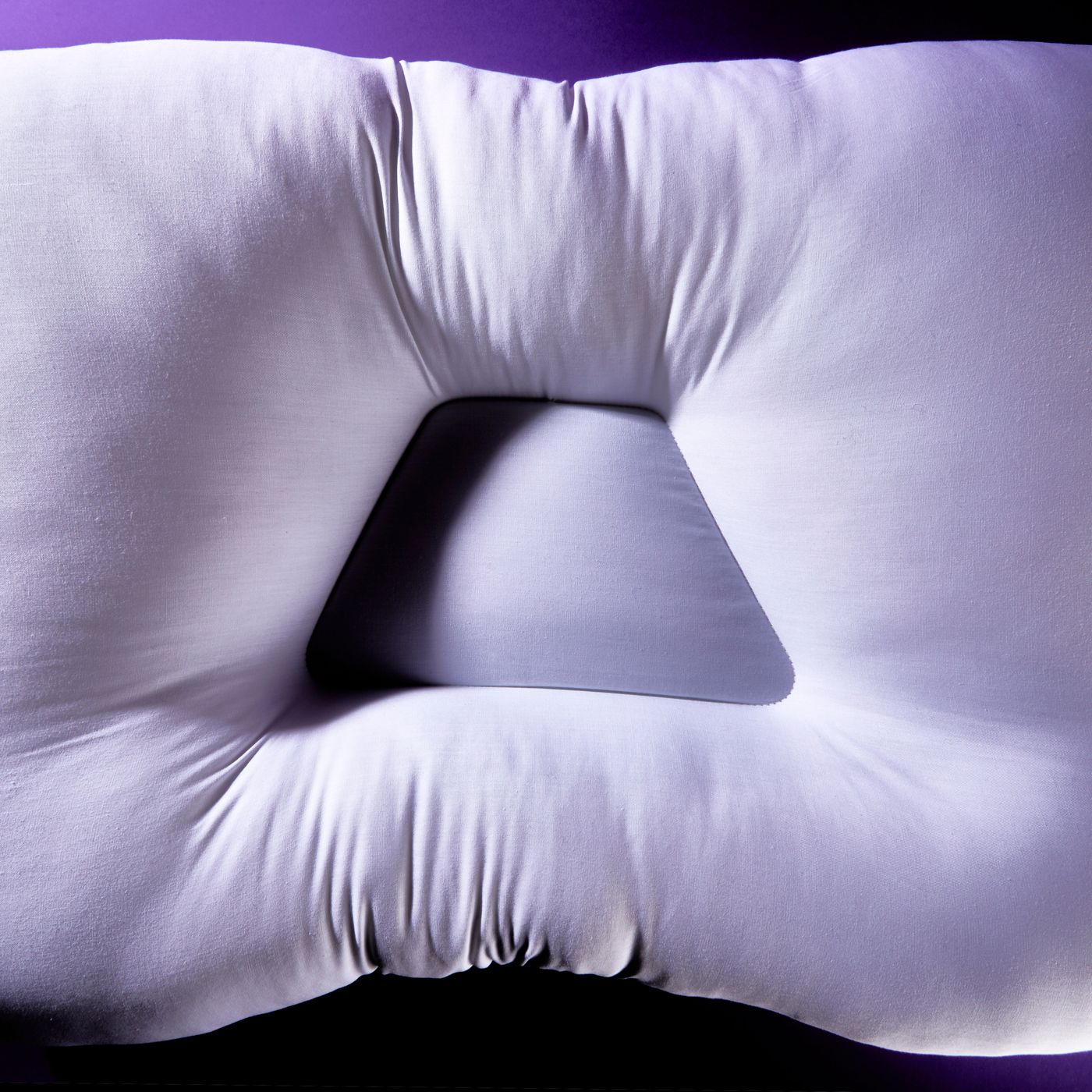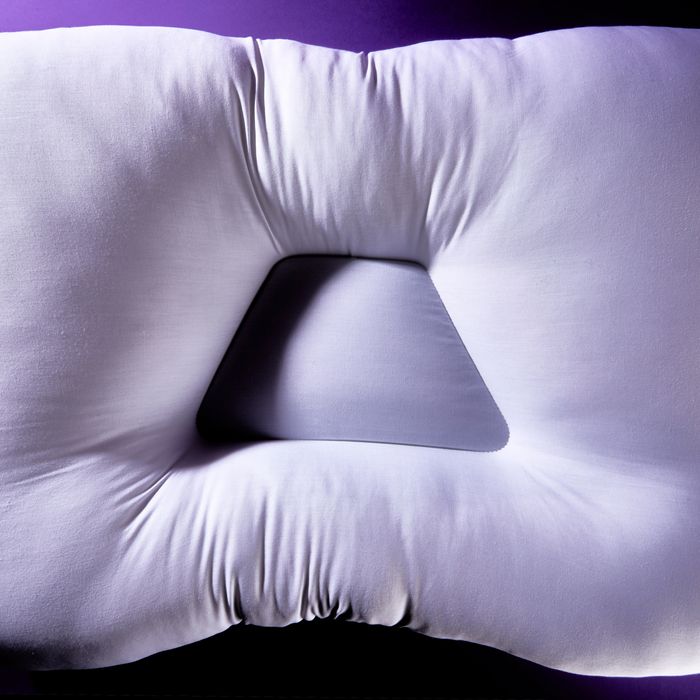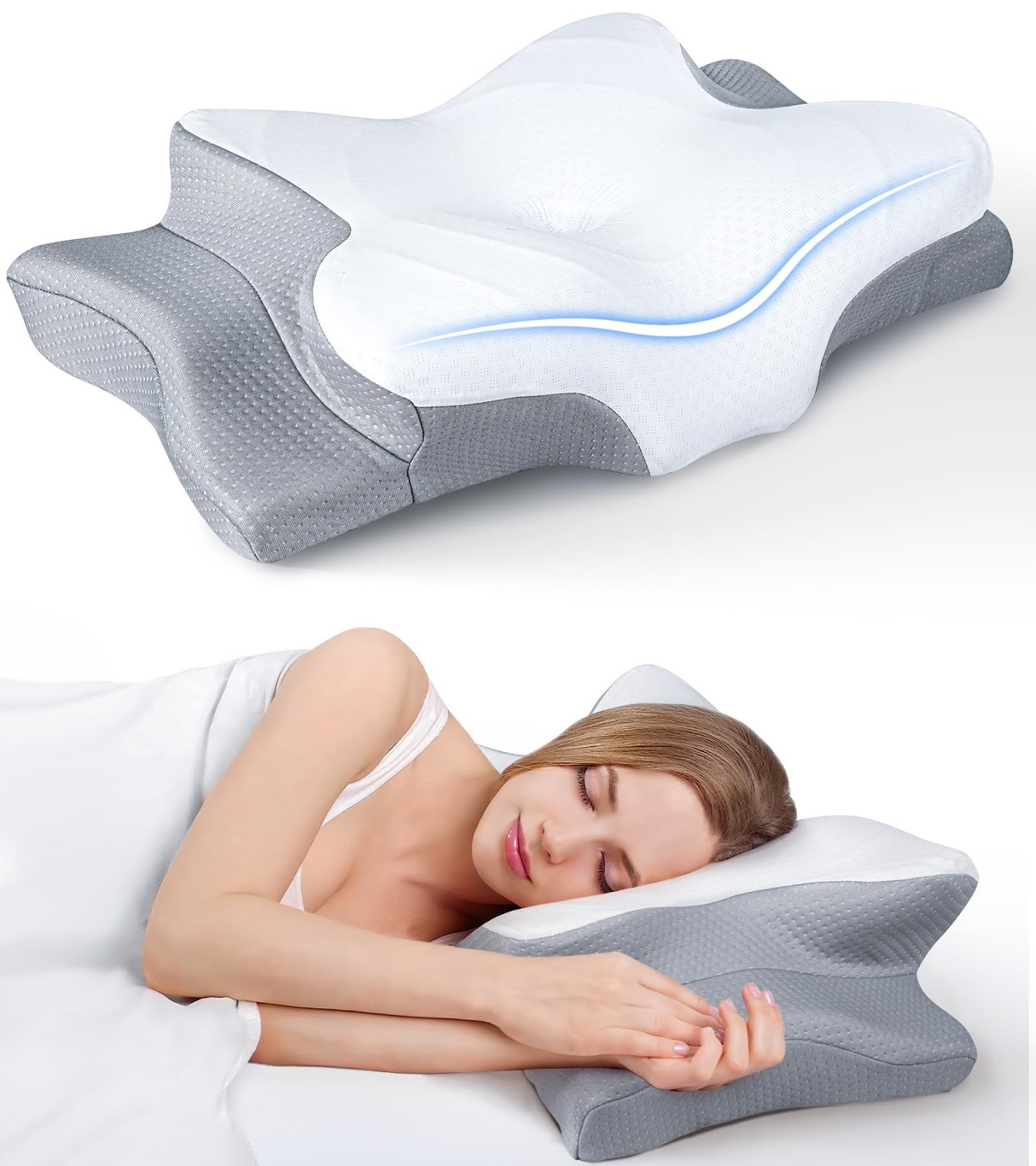Choosing the right pillow for neck pain starts with considering your sleeping position. You need a pillow that supports your neck and keeps your spine aligned.
Neck pain can disrupt your sleep and daily life. The right pillow can make a big difference. It provides proper support and can help reduce or eliminate neck pain. You may be wondering how to find the perfect pillow. It’s not just about comfort.
You need to think about your sleep habits and the pillow’s material. In this guide, we will explore what you need to know to make an informed choice. You deserve a good night’s sleep free from neck pain. So, let’s dive in and find the best pillow for you.
Importance Of A Good Pillow
Choosing the right pillow for neck pain is crucial for your overall well-being. A good pillow can significantly improve your sleep quality and provide relief from neck pain. It supports your head and neck, ensuring proper alignment of your spine. This can prevent discomfort and lead to a restful night’s sleep. Let’s delve into the importance of a good pillow and its impact on sleep quality and neck pain relief.
To Get The Best Pillow For Neck Pain – Visit Our Shop
Impact On Sleep Quality
A good pillow plays a vital role in ensuring quality sleep. The right pillow aligns your spine properly, which can help you avoid tossing and turning. This can lead to uninterrupted sleep and better rest. Here are some key points to consider:
- Support: A well-chosen pillow supports your head and neck, maintaining the natural curve of your spine.
- Comfort: A comfortable pillow helps you fall asleep faster and stay asleep longer.
- Material: The material of the pillow, whether memory foam, latex, or down, can affect your comfort and support levels.
Consider the following table that compares different pillow materials:
| Material | Support | Comfort |
| Memory Foam | High | Medium |
| Latex | High | High |
| Down | Medium | High |
Choosing the right pillow material can enhance your sleep quality. A good pillow provides the necessary support and comfort, leading to better sleep patterns and overall health.
Role In Neck Pain Relief
A good pillow is essential for relieving neck pain. It supports your neck and reduces pressure points, which can alleviate pain. Here are some important aspects to consider:
- Neck Alignment: A proper pillow ensures that your neck remains aligned with your spine, reducing strain.
- Pressure Relief: The right pillow distributes weight evenly, which can prevent pressure build-up in the neck area.
- Firmness: The firmness of the pillow affects how well it supports your neck. Choose a firmness level that suits your sleeping position.
Here are some tips to choose a pillow for neck pain relief:
- Side Sleepers: Use a firm pillow to keep your neck aligned with your spine.
- Back Sleepers: Opt for a medium-firm pillow that supports the natural curve of your neck.
- Stomach Sleepers: Use a soft pillow to avoid straining your neck.
Ensuring proper neck support can significantly reduce neck pain. A good pillow can provide the necessary relief by maintaining proper alignment and reducing pressure on your neck.

Types Of Pillows
Choosing the right pillow for neck pain can be a game-changer for your sleep quality and overall well-being. There are various types of pillows available, each with its unique features. Understanding these options can help you make an informed decision. Here, we explore three popular types: Memory Foam, Latex, and Feather and Down.
Memory Foam
Memory foam pillows are known for their ability to conform to the shape of your head and neck. This provides excellent support and alignment. Here are some key features and benefits of memory foam pillows:
- Support: Memory foam offers firm support, which helps in maintaining proper spinal alignment.
- Pressure Relief: It distributes weight evenly, reducing pressure points.
- Durability: These pillows tend to last longer than other types.
Memory foam pillows come in different shapes and sizes. Here are a few common types:
| Type | Features |
| Traditional | Single piece of foam, offers consistent support. |
| Contour | Has a curved design, ideal for back and side sleepers. |
| Shredded | Filled with shredded memory foam, offers adjustable loft. |
Considerations: Memory foam can retain heat, making it unsuitable for hot sleepers. Opt for gel-infused or ventilated options if you tend to sleep hot.
Latex
Latex pillows are another great option for those with neck pain. They offer a unique combination of support and comfort. Let’s delve into some of their benefits:
- Natural Material: Made from natural or synthetic latex, these pillows are hypoallergenic.
- Supportive: Latex provides firm yet bouncy support, maintaining spinal alignment.
- Breathable: They have excellent airflow, keeping you cool throughout the night.
Latex pillows come in various forms. Here are the main types:
| Type | Features |
| Dunlop | Denser and firmer, suitable for those needing extra support. |
| Talalay | Softer and more consistent, ideal for those seeking a plush feel. |
Considerations: Latex pillows can be heavier and more expensive than other types. Ensure you choose the right firmness level for your sleeping position.
Feather And Down
Feather and down pillows are known for their luxurious feel and softness. They offer a different kind of comfort and support compared to memory foam and latex. Here’s what makes them special:
- Softness: These pillows are incredibly soft and moldable, providing a cozy feel.
- Adjustability: You can adjust the fill to achieve your desired loft and firmness.
- Lightweight: Feather and down pillows are light and easy to move around.
These pillows come in different blends. Here are some common types:
| Type | Features |
| Feather | Filled with feathers, firmer than down, more affordable. |
| Down | Filled with soft undercoating of birds, very plush, more expensive. |
| Feather and Down Blend | Combination of both, offers a balance of support and softness. |
Considerations: Feather and down pillows may require frequent fluffing to maintain their shape. Also, they may not be suitable for those with allergies.
Pillow Loft And Firmness
Neck pain can disrupt sleep and daily life. Choosing the right pillow is essential for alleviating neck pain. Understanding pillow loft and firmness can guide you to the best choice. Loft refers to the pillow’s height and affects head and neck alignment. Firmness determines support and comfort levels. Let’s explore how to choose the perfect pillow to reduce neck pain.
Choosing The Right Loft
The loft of a pillow plays a crucial role in maintaining proper spinal alignment. A pillow that’s too high or too low can strain the neck and shoulders. Here’s how to choose the right loft:
- Sleeping Position: Different sleeping positions require different lofts.
- Back Sleepers: A medium-loft pillow is ideal. It keeps the head aligned with the spine.
- Side Sleepers: A high-loft pillow fills the gap between the neck and shoulder.
- Stomach Sleepers: A low-loft pillow reduces neck strain.
- Body Size and Weight: Heavier individuals may need a firmer, higher-loft pillow.
- Mattress Firmness: Soft mattresses often require lower loft pillows, while firm mattresses may need higher loft pillows.
Here’s a table summarizing the ideal loft for different sleeping positions:
| Sleeping Position | Ideal Loft |
| Back Sleepers | Medium Loft |
| Side Sleepers | High Loft |
| Stomach Sleepers | Low Loft |
Choosing the right loft ensures your neck remains in a natural position. This reduces pain and promotes better sleep quality.
Finding Ideal Firmness
The firmness of a pillow affects how well it supports your head and neck. The right firmness varies depending on personal preference and sleeping position. Consider the following guidelines:
- Sleeping Position: Different positions need different firmness levels.
- Back Sleepers: Medium-firm pillows provide the right balance of support and comfort.
- Side Sleepers: Firm pillows prevent the head from sinking too deep, keeping the spine aligned.
- Stomach Sleepers: Soft pillows reduce neck strain by allowing a more natural head position.
- Material: Pillow materials affect firmness levels. Memory foam pillows offer consistent support, while down pillows are softer and more malleable.
- Personal Preference: Some people prefer firmer support, while others like a softer feel. Testing different pillows can help find the perfect firmness.
Here’s a quick overview of firmness recommendations based on sleeping positions:
| Sleeping Position | Ideal Firmness |
| Back Sleepers | Medium-Firm |
| Side Sleepers | Firm |
| Stomach Sleepers | Soft |
Finding the ideal firmness ensures your pillow provides adequate support. This can significantly reduce neck pain and improve sleep quality.

Sleeping Positions
Choosing the right pillow for neck pain can be challenging. Your sleeping position plays a crucial role in determining the best pillow for your needs. Different sleeping positions require different types of support to maintain proper alignment and reduce strain on your neck.
Back Sleepers
Back sleepers need a pillow that supports the natural curve of the neck. A pillow that is too high or too low can cause strain. Here are some features to look for:
- Medium loft: A medium loft pillow, around 4-5 inches high, helps to keep your head and neck aligned.
- Firmness: Opt for a medium-firm pillow that maintains its shape and provides consistent support.
- Material: Memory foam or latex pillows conform to your neck’s contours, offering personalized support.
Consider using a pillow with a contoured design. This type of pillow has a dip in the middle to cradle your head and elevated edges to support your neck. If you experience lower back pain, placing a small pillow under your knees can help maintain the natural curve of your spine while you sleep.
Side Sleepers
Side sleepers need a pillow that fills the gap between the neck and shoulders. This helps keep the spine straight and reduces neck strain. Key features to consider include:
- High loft: A higher loft pillow, around 5-7 inches, supports the neck and keeps the head aligned with the spine.
- Firmness: A firmer pillow prevents the head from sinking too much and maintains proper alignment.
- Material: Memory foam, latex, or buckwheat pillows provide excellent support and conform to the neck and head.
Side sleepers might benefit from using a body pillow. A body pillow helps keep the spine aligned by supporting the knees and reducing the twist in the lower back. Choosing a pillow with adjustable fill can also be helpful. You can add or remove filling to achieve the perfect height and firmness.
Stomach Sleepers
Stomach sleepers face unique challenges. This position puts a lot of strain on the neck and spine. To minimize discomfort, consider the following:
- Low loft: A low loft pillow, around 2-3 inches, prevents excessive neck extension.
- Softness: A soft pillow reduces pressure on the neck and allows for some sinking.
- Material: Down or down alternative pillows are often softer and more comfortable for stomach sleepers.
Some stomach sleepers may find it comfortable to sleep without a pillow. This can help keep the neck in a more neutral position. If you experience lower back pain, placing a pillow under your pelvis can help maintain spinal alignment. Always ensure your mattress is supportive enough to prevent sagging, which can exacerbate neck pain.
Material Considerations
Choosing the right pillow for neck pain can make a huge difference in your comfort and health. One crucial factor to consider is the pillow’s material. Different materials offer various benefits, and understanding these can help you make an informed decision. Here, we will explore some key material considerations for pillows, focusing on hypoallergenic options and breathability and temperature control.
Hypoallergenic Options
If you have allergies or asthma, selecting a hypoallergenic pillow is essential. These pillows are designed to resist common allergens like dust mites, mold, and pet dander. Here are some popular hypoallergenic materials:
- Memory Foam: Memory foam pillows are dense and resist allergens. They also provide excellent neck support.
- Latex: Natural latex is both hypoallergenic and durable. It conforms to your neck and head for better alignment.
- Microfiber: These pillows are synthetic and often treated to be hypoallergenic. They are also soft and comfortable.
The following table provides a quick comparison of these materials:
| Material | Hypoallergenic | Durability | Comfort Level |
| Memory Foam | Yes | High | Firm |
| Latex | Yes | Very High | Medium to Firm |
| Microfiber | Yes | Medium | Soft |
Choosing a hypoallergenic pillow can help reduce symptoms like sneezing and itchy eyes. This leads to a more restful night and improved overall health.
Breathability And Temperature Control
Breathability and temperature control are important for maintaining a comfortable sleep environment. Some materials tend to retain heat, while others promote airflow. Here are some materials known for their breathability:
- Bamboo: Bamboo pillows are naturally breathable and wick away moisture. This keeps you cool and dry throughout the night.
- Gel-Infused Memory Foam: These pillows combine memory foam with cooling gel to offer both support and temperature regulation.
- Feather and Down: Natural materials like feathers and down provide excellent airflow. They are soft and moldable but may not be suitable for allergy sufferers.
The table below summarizes the breathability and temperature control of different pillow materials:
| Material | Breathability | Temperature Control | Comfort Level |
| Bamboo | High | Excellent | Soft to Medium |
| Gel-Infused Memory Foam | Moderate | Good | Firm |
| Feather and Down | High | Moderate | Soft |
Choosing a pillow with good breathability and temperature control can help prevent night sweats and overheating. This ensures you stay cool and comfortable all night long.

Neck Support Features
Choosing a pillow for neck pain can be a daunting task. The right pillow should provide ample support to your neck and head. Neck support features play a crucial role in relieving pain and ensuring a good night’s sleep. Here, we explore two popular types of pillows that offer excellent neck support: contour pillows and adjustable pillows.
Contour Pillows
Contour pillows are designed to conform to the natural curve of your neck and head. These pillows usually have a dip in the center and raised edges. This design helps maintain the alignment of your spine while you sleep. Key features include:
- Ergonomic Design: The contoured shape follows the curve of your neck, providing targeted support.
- Material: Often made from memory foam, which molds to your body’s shape and offers firm support.
- Height: Available in different heights to suit various sleeping positions (back, side, stomach).
The table below highlights the pros and cons of contour pillows:
| Pros | Cons |
| Supports natural alignment | May feel too firm for some |
| Reduces neck and shoulder pain | Takes time to get used to |
| Durable and long-lasting | Heavier than regular pillows |
Contour pillows are ideal for those who need specific neck support. They are particularly beneficial for side and back sleepers. Always consider the pillow’s height and firmness to find the best fit for your needs.
Adjustable Pillows
Adjustable pillows provide customizable support to suit your individual needs. These pillows allow you to add or remove filling to achieve the desired height and firmness. Features to look for include:
- Customizable Height: Adjust the pillow’s height by adding or removing filling.
- Versatile Filling: Often filled with shredded memory foam, latex, or down alternative.
- Flexibility: Suitable for all sleeping positions (back, side, stomach).
The table below highlights the pros and cons of adjustable pillows:
| Pros | Cons |
| Customizable for personal comfort | Requires occasional adjustment |
| Suitable for all sleep positions | Can be messy to adjust |
| Breathable and cooling options available | May be more expensive |
Adjustable pillows are great for those who want flexible support. They are ideal if you change sleeping positions often or have specific comfort preferences. Look for pillows with high-quality materials to ensure durability and comfort.
Trial And Error
Choosing the right pillow for neck pain often involves a process of trial and error. This means testing different types of pillows to see which one offers the best relief and support for your neck. It’s not always a one-size-fits-all solution, so experimenting with various options is crucial. Let’s explore two important aspects of this trial and error process: return policies and testing comfort levels.
Return Policies
Return policies are essential when testing pillows for neck pain. Not every pillow will suit your needs, so having the option to return an unsatisfactory pillow is important. Here are a few things to consider:
- Duration: Check how long you have to return the pillow. Some stores offer a 30-day return policy, while others may offer up to 90 days.
- Condition: Ensure you can return the pillow even after trying it. Some policies require the pillow to be in like-new condition, while others are more lenient.
- Refunds: Determine if you will get a full refund or store credit. Full refunds are preferable if you want to try different stores or brands.
Here’s a quick comparison of typical return policies:
| Store | Return Period | Condition Required | Refund Type |
| Store A | 30 Days | Like-New | Full Refund |
| Store B | 60 Days | Any Condition | Store Credit |
| Store C | 90 Days | Like-New | Full Refund |
Testing Comfort Levels
Comfort is subjective, and testing different pillows is the best way to find what suits you. Here are some tips to help you test comfort levels effectively:
- Sleep Position: Consider your usual sleep position. Side sleepers may need a thicker pillow, while back sleepers might prefer a thinner one.
- Support: Focus on how well the pillow supports your neck. You want your spine to be in a neutral position.
- Material: Test different materials such as memory foam, latex, or down. Each has unique properties that can affect comfort.
Here’s a guide to different pillow materials and their benefits:
| Material | Benefits |
| Memory Foam | Molds to the shape of your neck, providing customized support |
| Latex | Offers a firmer support and is hypoallergenic |
| Down | Soft and adjustable, good for those who move a lot in sleep |
Remember, it may take a few nights to determine if a pillow is right for you. Give each pillow a fair trial period before making a decision.
Maintenance And Care
Choosing the right pillow for neck pain involves more than just selecting the right material and firmness. Proper maintenance and care are essential to ensure the pillow remains effective and hygienic. Regular cleaning and timely replacement can help in maximizing comfort and longevity of your pillow. Below are some guidelines to help you maintain and care for your pillow effectively.
Cleaning Guidelines
Keeping your pillow clean is crucial for maintaining its support and comfort. Follow these cleaning guidelines to ensure your pillow remains fresh and effective:
- Read the Label: Always check the manufacturer’s care instructions. Different materials require different cleaning methods.
- Regular Washing: Wash your pillow every 4 to 6 months. Memory foam pillows should be spot cleaned, while down or feather pillows can usually be machine washed.
- Use a Pillow Protector: A protector can shield your pillow from sweat, oils, and dust mites. Wash the protector every 1 to 2 weeks.
- Dry Thoroughly: Ensure your pillow is completely dry after washing. Moisture can lead to mold and mildew. Use a low-heat setting in the dryer or air dry in a sunny spot.
- Fluff Regularly: Fluffing your pillow daily helps maintain its shape and support. This is especially important for down and feather pillows.
Replacement Tips
Even with the best care, pillows do not last forever. Knowing when to replace your pillow can make a significant difference in managing neck pain. Here are some replacement tips:
- Lifespan: Most pillows should be replaced every 1 to 2 years. This ensures they provide adequate support and hygiene.
- Signs of Wear: If your pillow is lumpy, flat, or no longer holds its shape, it is time for a new one. A pillow that has lost its support can worsen neck pain.
- Allergies: If you notice an increase in allergies or respiratory issues, it might be due to dust mites and allergens in the pillow. Consider replacing it.
- Odors: Persistent odors that do not go away after washing indicate that it’s time to get a new pillow.
- Testing Your Pillow: Fold your pillow in half and see if it springs back to its original shape. If it doesn’t, it’s likely time for a replacement.
Maintaining and replacing your pillow regularly can greatly impact your sleep quality and help alleviate neck pain. Keeping these tips in mind will ensure your pillow remains a supportive and hygienic part of your sleep routine.
Frequently Asked Questions
What Type Of Pillow Is Best For Neck Pain?
A memory foam or cervical pillow supports the neck. It helps reduce pain.
How High Should A Pillow Be For Neck Pain?
A pillow should be 4 to 6 inches high. It keeps your neck aligned.
Can A Firm Pillow Help With Neck Pain?
Yes, a firm pillow provides better support. It keeps your neck in a neutral position.
Should I Use One Or Two Pillows For Neck Pain?
Use only one pillow. Two pillows can cause neck strain and increase pain.
Conclusion
Choosing the right pillow for neck pain can improve your sleep. Focus on your sleeping position and pillow firmness. Pay attention to the pillow material and loft. Comfort and support are key. Test different options to find the best fit.
Your neck will thank you. Remember, a good pillow can make a big difference. Sleep well and wake up pain-free.

